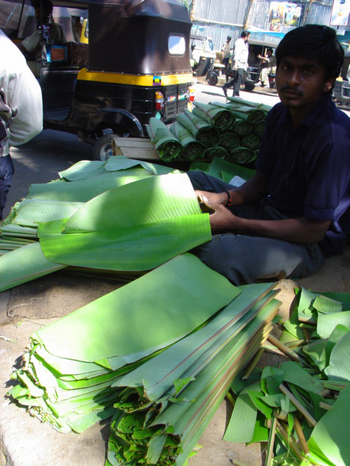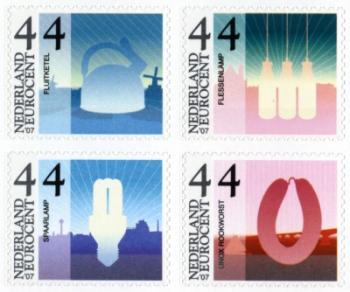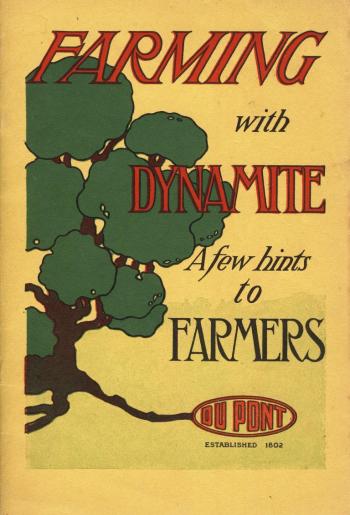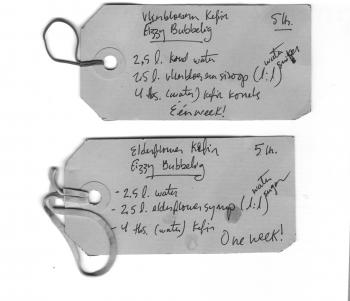This weekend:
Massive Dutch protests against the obliteration of cultural funding!
June 25, 2011
Dutch text below is not a direct translation.
Imagine this: you’re an internationally recognised Dutch cultural institution of art/design/media culture. You have a substantial collection; media art, landscape art, but also paintings/ sculptures/ installations/ photography/ film/ design objects/ and artist-activist works in the public space that regenerate your city’s ill-planned urban areas. In short, you host a platform for innovation representing the entire gamut of your discipline. Over the past decades you have made substantial cultural impact in your field and thus you are considered to be a driver of culture. The artists/designers/architects whose works comprise your collection and fill your programming are also recognized internationally, and they often represent the Netherlands all over the world, in biennials and important exhibitions.
And then one day you receive a letter from the new Dutch Ministry of Culture that your funding will be completely withdrawn as of January 1, 2013. What do you do with your collection? Your staff? Your buildings? Your publications? The rest of the year’s programming? What will the artists/activists/designers/architects and your engaged public do, now that they no longer have access to your platform?
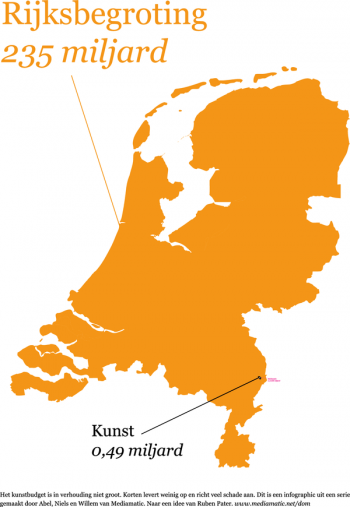
Infographic illustrating the proportion of cultural spending in comparison to the total Dutch national budget. Miljard = billion.
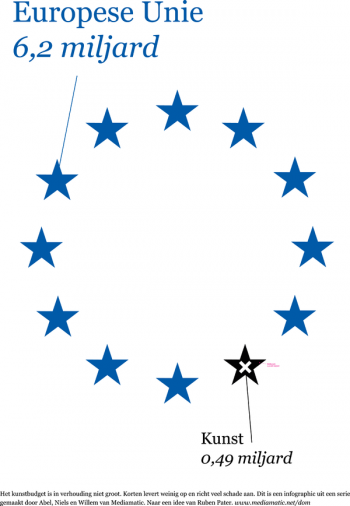
Infographic illustrating the proportion of cultural spending compared to the total budget of EU spending. Miljard = billion.
This Sunday and Monday the Dutch cultural sector will gather and protest en masse the unspeakably ill-informed budget cuts proposed by Secretary of State Halbe Zijlstra. These cuts are not simply across-the-board austerity measures taken from all sectors, but represent the destruction of Dutch cultural heritage in one fell swoop. Aside from the radical and sometimes COMPLETE obliteration of budgets for new media culture, design, art in the public space, and architecture, Zijlstra’s proposed budget, which ignores the advice given by his own advisory panel, will also severely and negatively impact spending in the areas of science, health care, and the environment.
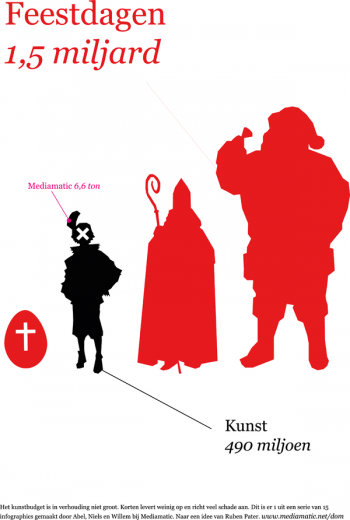
Infographic illustrating the proportion of cultural spending in comparison to the annual amount of Dutch spending on Christian holidays.
Shockingly, though not surprisingly, the proposed cultural sector budget erasures represent a proportional drop in the bucket of overall national spending, less than 1%. By comparison, a 1% reduction in our annual asphalt budget alone would make cuts in culture in these areas unnecessary.
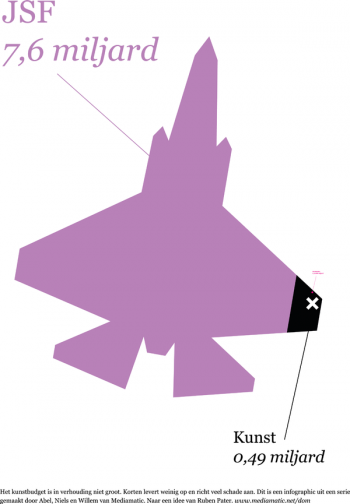
Infographic illustrating the proportion of cultural spending in comparison to the budget for the Joint Strike Fighter.
The Dutch cultural sector has produced a counter proposal which you can read here.
Here is a list of actions we can all take before June 27 that will likely impact the parliamentary debates on Monday:
A no less less emotional (Dutch) version of the above post below I have excerpted from the Sonic Acts. On their website is an even lengthier and impassioned English version - a worth read for those trying to inform themselves about the current political situation in the Netherlands:
Op vrijdag 10 juni 2011 viel de brief ‘Meer dan kwaliteit’ van de staatssecretaris voor cultuur, Halbe Zijlstra (VVD), in de elektronische postbus van Nederlandse instellingen voor kunst en cultuur. Daarin werd uitgelegd hoe met de botte bijl 200 miljoen euro bezuinigd zou moeten worden op kunst en cultuur, en wel met ingang van 1 januari 2013. Zijlstra, die er rond voor uit komt geen enkel verstand te hebben van kunst en cultuur, bleek alle adviezen, waaronder die van de Raad voor Cultuur (officieel adviesorgaan van de overheid) naast zich te hebben neergelegd. Subsidies voor een beperkt aantal ‘topinstellingen’ zoals de Nederlandse Opera, die sowieso al een groot deel van het beschikbare budget verbruiken, blijven gehandhaafd. Het grootste deel van de andere instellingen mogen wat hem betreft verdwijnen – ze kunnen niet meer rekenen op structurele ondersteuning van het rijk. Bovendien wordt het budget dat beschikbaar zal zijn voor projectsubsidies – voor individuele kunstenaars, eenmalige projecten, festivals – meer dan gehalveerd. Alleen ‘internationaal toptalent’ en kunst die zich al bewezen heeft, mag blijven.
Hier is niet zomaar sprake van een verwachte bezuinigingsoperatie van een centrumrechts minderheidskabinet dat aan de leiband loopt van de populistische PVV. Hier is sprake van een rechtstreekse aanval op de kunst, een aanval op alles wat niet binnen een markteconomie past, alles wat zich niet wil of laat voegen naar de logica van een populistisch getint neoliberalisme. Het betekent het einde van een met veel inspanning en moeite opgebouwde cultuur. Er staan wel wat obligate zinnetjes in de brief waaruit een slecht lezer de indruk zou kunnen krijgen dat er sprake is van een beleidsvisie, maar elke inhoudelijke frase wordt tegengesproken door de voorgenomen maatregelen. Uit de brief spreekt ressentiment jegens vernieuwende en onderzoekende kunst, jegens kunst die nieuwe wegen probeert in te slaan, en die zich niet kan bedruipen van de markt alleen. Er spreekt minachting uit voor het werk van kunstenaars, minachting voor de rijke ervaring die kunst kan opleveren, minachting voor de mensen die daarvan genieten en profiteren. Dat kunst een bijdrage levert aan de samenleving en aan innovatie wordt genegeerd. Dat kunst en cultuur een publiek belang hebben, wordt ontkend; in feite wordt ontkend dat er zoiets als een publiek belang bestaat. Alleen wat ‘de markt’ – wat dat ook moge zijn – of een rijke mecenas wil betalen, heeft bestaansrecht. De brief is een knalharde oekaze. Onder de zweep van het populistisch neoliberalisme op naar ondergang.
Er is geen enkele beleidsreden om 200 miljoen te bezuinigen. Het is zo afgesproken met de PVV in ruil voor gedoogsteun voor het minderheidskabinet in het parlement. De bedoeling ervan: onherstelbare schade toe brengen aan een complete beroepsgroep. Zijlstra tracht deze beroepsgroep te decimeren en het creatieve, innovatieve en kritische potentieel dat ze bezit uit te schakelen. Geen lid van zijn eigen VVD of coalitiepartner CDA die hem tegenspreekt. Wat hen betreft is de traditionele kunst een overbodig ornament van de samenleving. De hedendaagse kunst worden bestempeld als vervreemd en ja, al zal niemand dat woord gebruiken: ‘entartet’.
Read more here:
debra at 14:01 | Comments (2) | post to del.icio.us

